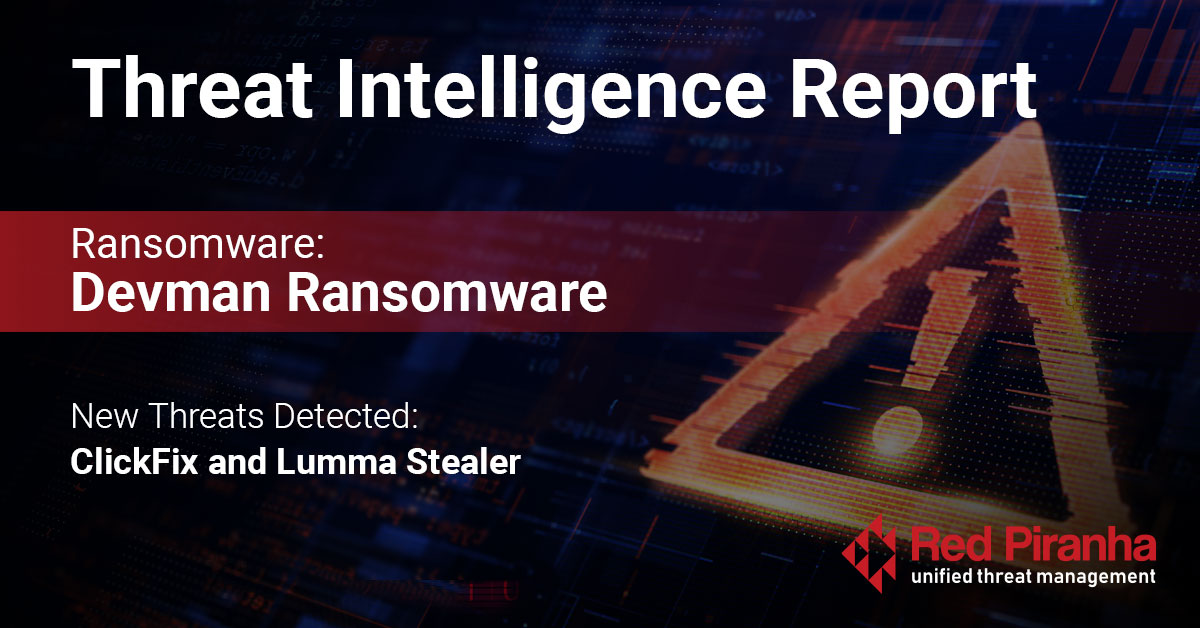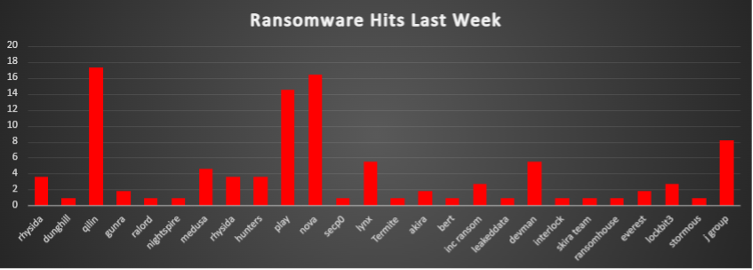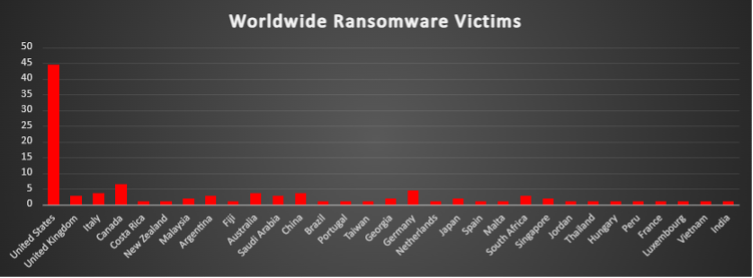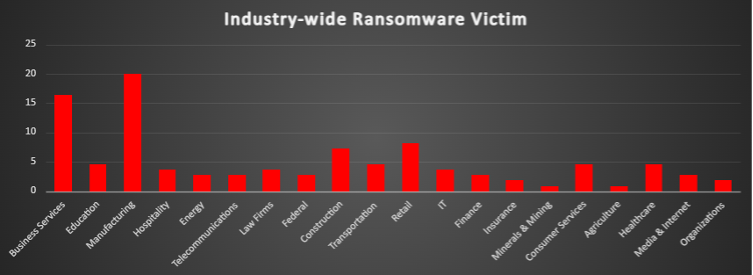
| New Threat Detection Added | 2 |
| • ClickFix • Lumma Stealer | |
| New Threat Protections | 205 |
Weekly Detected Threats
The following threats were added to Crystal Eye this week:
Threat name: | ClickFix | ||||||||||||||||||
ClickFix is a social engineering attack technique that creates pop-ups alerting the user that if something has gone wrong on their computer then they can fix it by clicking buttons labelled “Fix It” or “Copy Fix”. By pressing these buttons, it saves a malicious command to the user clipboard, and they are instructed to open PowerShell and paste it in, this then executes a payload that comprises the user’s system. The initial infection that causes the “pop-ups” to occur is usually delivered through phishing emails. | |||||||||||||||||||
Threat Protected: | 08 | ||||||||||||||||||
Rule Set Type: |
| ||||||||||||||||||
Class Type: | Malware | ||||||||||||||||||
Kill Chain: |
| ||||||||||||||||||
Threat name: | Lumma Stealer | ||||||||||||||||||
Lumma Stealer has been around since 2022 and has grown to be one of the most prominent “info stealer” malware. Lumma Stealer uses the MaaS (Malware-as-a-Service) model and primarily targets Cryptowallets, User Credentials and Multifactor Authentication Web browser extensions for users on Windows systems as payloads are delivered in EXE, DLL and PowerShell formats. | |||||||||||||||||||
Threat Protected: | |||||||||||||||||||
Rule Set Type: |
| ||||||||||||||||||
Class Type: | Domain-c2 | ||||||||||||||||||
Kill Chain: |
| ||||||||||||||||||
Known Exploited Vulnerabilities (Week 1 - May 2025)
For more information, please visit the Red Piranha Forum:
https://forum.redpiranha.net/t/known-exploited-vulnerabilities-catalog-1st-week-of-may-2025/562
Vulnerability | CVSS | Description | |
CVE-2025-31324 | 10.0 (Critical) | SAP NetWeaver Unrestricted File Upload Vulnerability | |
CVE-2024-38475 | 9.1 (Critical) | Apache HTTP Server Improper Escaping of Output Vulnerability | |
CVE-2023-44221 | 7.2 (High) | SonicWall SMA100 Appliances OS Command Injection Vulnerability | |
CVE-2025-34028 | 10.0 (Critical) | Commvault Command Center Path Traversal Vulnerability | |
CVE-2024-58136 | 9.8 (Critical) | Yiiframework Yii Improper Protection of Alternate Path Vulnerability |
Updated Malware Signatures (Week 4 - May 2025)
Threat | Description | |
Lumma Stealer | A type of malware classified as an information stealer. Its primary purpose is to steal sensitive information from infected systems, including but not limited to credentials, financial information, browser data, and potentially other personal or confidential information. | |
XWorm | A Remote Access Trojan (RAT) and malware loader that's commonly used in cyberattacks to give attackers full remote control over a victim's system. It's part of a growing trend of commercialised malware sold or rented on dark web forums, often under the guise of a “legitimate tool.” |
| Ransomware Report | |
The Red Piranha Team conducts ongoing surveillance of the dark web and other channels to identify global organisations impacted by ransomware attacks. In the past week, our monitoring revealed multiple ransomware incidents across diverse threat groups, underscoring the persistent and widespread nature of these cyber risks. Presented below is a detailed breakdown of ransomware group activities during this period. Ransomware Victims Worldwide Qilin tops the list with 17.27%. Nova follows at 16.36%, continuing its rise from a mid-tier outfit into a true “big game” player. Play sits close behind on 14.55%; the group’s fast-moving Linux/VMware lockers keep MSPs and industrial targets in its sights. J Group accounts for 8.18%. While smaller, its opportunistic hit list shows wide geographic spread. Rhysida posts 7.28% (two separate listings in the raw feed). Their hallmark is hands-on-keyboard intrusions that end in quick ESXi or Windows encryption. A solid 40%+ of all observed attacks stem from these top three families alone, underscoring a highly concentrated threat environment. Mid-packed actors such as Lynx and Devman (each at 5.45%) plus Medusa, Hunters, and Inc Ransom round out the top ten, reinforcing the long-tail of persistent but less prolific gangs. Victims continue to span every vertical—from manufacturing and professional services to healthcare—highlighting that defensive priorities must remain industry-agnostic: patch velocity, credential hygiene, and robust off-network backups are still the best universal shields against this concentrated onslaught. | |
| Name of Ransomware Group | Overall %age of total attack coverage |
3.64% | |
Dunghill | 0.91% |
17.27% | |
Gunra | 1.82% |
RAlord | 0.91% |
NightSpire | 0.91% |
4.55% | |
3.64% | |
Hunters | 3.64% |
14.55% | |
Nova | 16.36% |
Secp0 | 0.91% |
Lynx | 5.45% |
Termite | 0.91% |
Akira | 1.82% |
Bert | 0.91% |
Inc Ransom | 2.73% |
Leaked Data | 0.91% |
Devman | 5.45% |
Interlock | 0.91% |
Skira Team | 0.91% |
RansomHouse | 0.91% |
Everest | 1.82% |
2.73% | |
Stormous | 0.91% |
J Group | 8.18% |

Devman Ransomware Group
Devman burst onto the scene in mid-April 2025, appearing on the dark web leak markets with an initial wave of more than a dozen victims. Early chatter on threat-intel forums suggests the operator is a former affiliate of the Qilin/Agenda RaaS who has split off to launch a brand-new franchise while still collaborating on some jobs. Public breach posts credited jointly to “Qilin & Devman” (e.g., the Feel Four S.L. retail attack) confirm that the newcomer is already comfortable partnering with established crews.
From the start, Devman has embraced a double-extortion business model: data is stolen first, then systems are encrypted, and finally the victim is pressured with public disclosure on a leak portal if payment is refused. Victims span retail, construction, healthcare, manufacturing, and IT services across Asia, Europe, Africa, and North America, underscoring an opportunistic, RaaS-style targeting philosophy rather than a single-sector focus.
Detailed TTPs
Devman ransomware campaigns begin by exploiting vulnerable perimeter services such as unpatched VPN gateways or ESXi hosts. A 64-bit payload runs with administrator privileges, leveraging native APIs and command-line execution. Persistence and lateral spread rely on scheduled services, Run-key hijacking, and PsExec-driven SMB propagation. The malware escalates privileges through service abuse, then disables security products and wipes Windows or ESXi logs. It enumerates shares and domains, stages stolen data, and exfiltrates archives through encrypted channels. Negotiations use peer-to-peer Tox while a public leak site amplifies pressure. Finally, robust encryption and snapshot deletion cripple recovery, forcing ransom payments from victims worldwide.
Stage | Techniques Observed |
Initial Access | |
Execution | • 64-bit payload executed with admin rights. • Native API & command-line invocation (T1106/T1059). |
Persistence & Lateral Movement | • Scheduled services or modified Run keys (T1543). • PsExec/SMB for cross-host propagation (T1021). |
Privilege Escalation | • Abuse of service installs/token privileges (T1548). |
Defence Evasion | • Stops AV/backup services & clears Windows/ESXi logs (T1562). |
Discovery | • Network share and domain discovery to maximise impact (T1135). |
Exfiltration | • Bulk file staging then exfiltration over encrypted channels (T1041). |
Command-and-Control | |
Impact | • Data-Encrypted-for-Impact (T1486). |
TTP Chart
Tactic | Technique | ID | Description |
Initial Access | Exploit Public-Facing Application | T1190 | Weaponises un-patched VPN/ESXi services |
Execution | Native API | T1106 | Runs encryption routines directly via Win32 APIs |
Persistence | Create/Modify System Process | T1543 | Installs malicious service for re-launch |
Priv-Esc | Abuse Elevation Control Mechanism | T1548 | Uses built-in admin tokens |
Defence Evasion | Impair Defences | T1562 | Terminates security & backup processes |
Discovery | Network Share Discovery | T1135 | Enumerates shares before encryption |
Lateral Move | Remote Services (PsExec/SMB) | T1021 | Spreads to adjacent hosts |
Exfiltration | Exfiltration Over C2 Channel | T1041 | Sends archives to TA-controlled servers |
C2 | Application-Layer Protocol (Tor/Tox) | T1071.001 | Negotiation & leak-site hosting |
Impact | Data Encrypted for Impact | T1486 | Encrypts files with AES + RSA |
Impact | Inhibit System Recovery | T1490 | Deletes snapshots/shadow copies |
IOCs
Indicator Type | Value |
Onion URL | qljmlmp4psnn3wqskkf3alqquatymo6hntficb4rhq5n76kuogcv7zyd.onion |
Clearnet IP | 83.217.209.210 |
File Extension | .devman |
Ransom Note | recover_files.txt |
ESXi Target Path | /vmfs/volumes/* |
Negotiation Channel | Tox messenger ID (unique per victim) |
Other Indicators
- Surge in CPU/Disk utilisation as w.exe (or similarly named binary) spawns across servers.
- Sudden stop of backup/AV services (vss, sql, vmware-hostd, etc.).
- Large outbound traffic burst to Tor relay IPs just before encryption.
Ransomware Victims Worldwide
A fresh review of public victim-site postings for the current period confirms that the United States remains the epicentre of ransomware activity, absorbing an outsized 44.55% of all known incidents. The figure is even higher than last period’s 39.62%, underscoring the country’s unmatched concentration of high-value infrastructure and data-rich enterprises that continue to attract both profit-driven and geopolitically motivated actors.
Canada emerges as a distant—but still notable—second with 6.36% of global cases, signalling a steady rise in attacks across North America outside the US mainland. Germany follows at 4.55%, reflecting the persistent targeting of Europe’s industrial and manufacturing heartland. A trio of nations each record 3.64% of incidents: Italy, Australia, and China. Italy’s presence highlights sustained Southern-European exposure, while concurrent activity in Australia and China points to the Asia-Pacific theatre’s growing importance for threat actors seeking both Western and regional targets.
The mid-tier impact is visible in the United Kingdom (2.73%) and Saudi Arabia (2.73%), alongside Argentina and South Africa (each 2.73%). These numbers suggest that both established economies and key emerging markets remain firmly on adversaries’ radar. Nations posting 1.82% of incidents include Malaysia, Georgia, Japan, and Singapore—an indicator of ransomware’s reach into South-East Asian, Caucasian, and East-Asian digital ecosystems.
A broad long-tail of countries each account for 0.91% of reported cases—among them Brazil, Portugal, Taiwan, The Netherlands, Spain, Malta, Jordan, Thailand, Hungary, Peru, France, Luxembourg, Vietnam, India, Costa Rica, New Zealand, and the island nation of Fiji. Although individual volumes are low, the sheer geographic diversity of these sightings underlines ransomware’s truly transnational footprint.
| Countries | Worldwide Ransomware Victims |
United States | 44.55% |
United Kingdom | 2.73% |
Italy | 3.64% |
Canada | 6.36% |
Costa Rica | 0.91% |
New Zealand | 0.91% |
Malaysia | 1.82% |
Argentina | 2.73% |
Fiji | 0.91% |
Australia | 3.64% |
Saudi Arabia | 2.73% |
China | 3.64% |
Brazil | 0.91% |
Portugal | 0.91% |
Taiwan | 0.91% |
Georgia | 1.82% |
Germany | 4.55% |
The Netherlands | 0.91% |
Japan | 1.82% |
Spain | 0.91% |
Malta | 0.91% |
South Africa | 2.73% |
Singapore | 1.82% |
Jordan | 0.91% |
Thailand | 0.91% |
Hungary | 0.91% |
Peru | 0.91% |
France | 0.91% |
Luxembourg | 0.91% |
Vietnam | 0.91% |
India | 0.91% |

Ransomware Victims by Industry
The Manufacturing sector remains the most targeted, accounting for 20% of ransomware attacks, highlighting its reliance on industrial systems and the high cost of operational downtime. Business Services follow at 16.36%, as threat actors exploit their access to sensitive client data and widespread integration in supply chains.
The Retail sector ranks third with 8.18%, frequently targeted due to high transaction volumes and customer data. Construction follows with 7.27%, reflecting risks tied to disrupted project timelines and infrastructure operations.
Sectors like Education, Transportation, Healthcare, and Consumer Services each report 4.55%, showing consistent pressure on institutions that manage personal data or critical services. Hospitality, Law Firms, and IT each see 3.64% of attacks, pointing to the exploitation of availability and legal or technical data.
Energy, Telecommunications, Finance, Federal, and Media & Internet each account for 2.73%, while Insurance and Organisations report 1.82%. Even niche industries like Minerals & Mining and Agriculture, each at 0.91%, are now on the radar.
This broad impact underscores ransomware’s cross-industry reach. Regardless of size or sector, all organisations must adopt tailored defences, ensure regular backups, and maintain response readiness to counter the ever-evolving ransomware threat.
| Industries | Industry-wide Ransomware Victims |
Business Services | 16.36% |
Education | 4.55% |
Manufacturing | 20% |
Hospitality | 3.64% |
Energy | 2.73% |
Telecommunications | 2.73% |
Law Firms | 3.64% |
Federal | 2.73% |
Construction | 7.27% |
Transportation | 4.55% |
Retail | 8.18% |
IT | 3.64% |
Finance | 2.73% |
Insurance | 1.82% |
Minerals & Mining | 0.91% |
Consumer Services | 4.55% |
Agriculture | 0.91% |
Healthcare | 4.55% |
Media & Internet | 2.73% |
Organisations | 1.82% |

